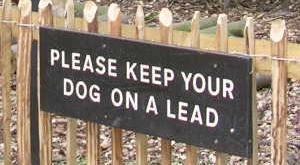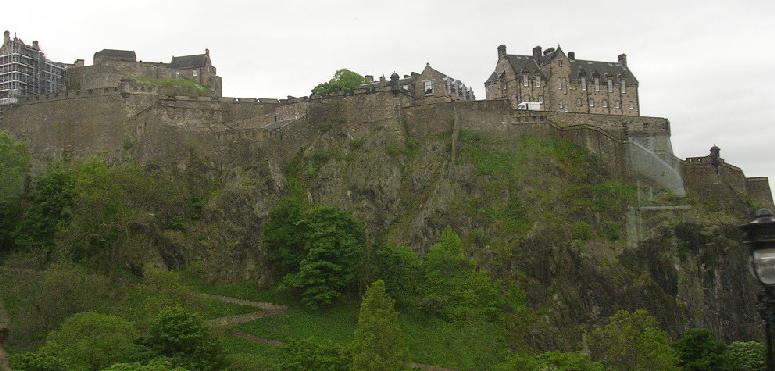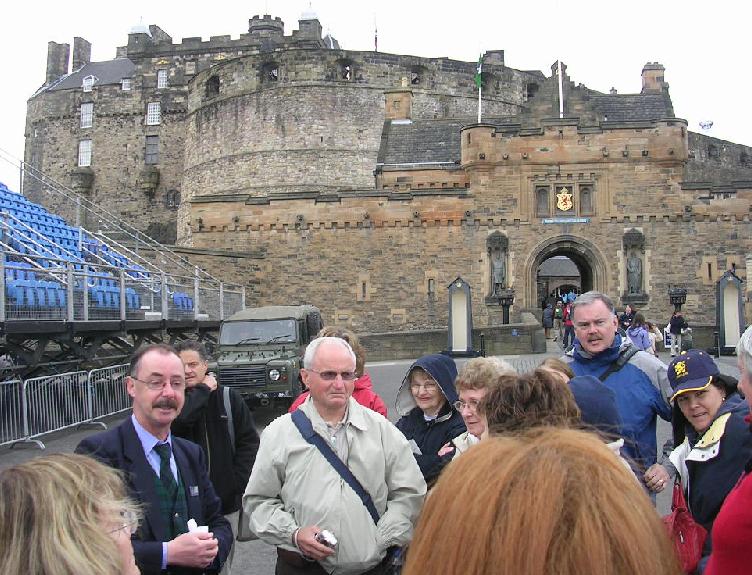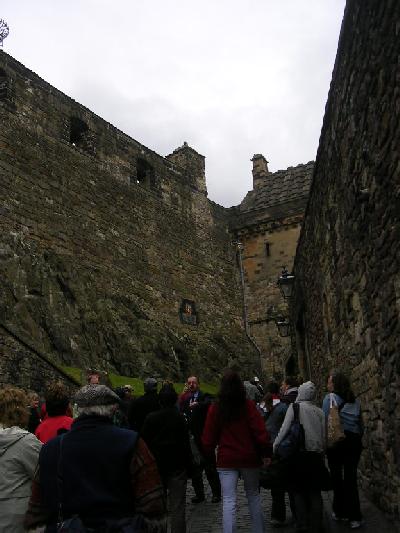 |
 |
 |
 |
| Day 5: I managed to get a little over five hours of sleep that
night, waking up at 4:45. The sun was just trying to come up in the east.
I tried to doze until 6:30, when I finally got up. Our wake-up call came
at 6:45:
Desk clerk (male): "This is your wake-up
call."
As I hung up, I concluded, the British are just different. Downstairs, we ate with Jeanie and Susan, from Phoenix. I mentioned to the hostess what a beautiful city Edinburgh was, and she agreed. "I see something new every day," she said. We had a different tour guide that morning, a cheerful Scot named Bill. The plan was for us all to be on the coach at 8:30 for our morning tour of Edinburgh. We rode down the early-morning streets, busy with traffic that Monday, May 28th. Even though many of the buildings in town were built with golden limestone, the walls are all dark and cloudy. That's because of centuries of people in town burning coal for heat. The older buildings still sprout chimney pots from their roofs. The soot piled on and got absorbed into the stone. Edinburgh got the nickname "Auld Reekie" because of all the smoke. The Sir Walter Scott memorial downtown is almost completely black from years of soot in the air. People were still burning coal in their fireplaces right up until 1964. Local citizens are divided on the idea of cleaning off the old buildings, to expose the beautiful stone underneath, or just leaving the buildings the way they are. Some have suggested the soot actually protects the buildings from modern pollution. The debate continues. In Charlotte Square, we saw some magnificent Georgian architecture. Bill pointed out some of the "class-conscious" stonework. Rusticated masonry in the upper parts of the buildings shows off the limestone in large, bold blocks. Right below street level, however, where the servants would have lived, the exterior stonework changes abruptly to cheaper, coarser stone. Charlotte Square is in "New Town," the part of Edinburgh that expanded beyond the original medieval "Old Town." Bill pointed out the Fettes College, one of the most expensive private schools in Britain. Prime Minister Tony Blair and author Ian Fleming were alumni. We passed the Caledonian Hotel, built of unusual red sandstone. We journeyed into the Old Town and headed for Edinburgh Castle.  The castle itself was on top of an extinct volcano, and was built and added on to over hundreds of years. Outside the main entrance, workers were busy erecting huge sets of bleachers. They were getting ready for the 58th Edinburgh Military Tattoo. Every August, military bands from all over the world come to perform in Edinburgh, attracting thousands of spectators. The wide area in front of the castle where the bleachers were being built was called the Esplanade. Bill the guide said it took ten weeks to erect the bleachers for the event, and ten weeks to take it all back down again.    The castle is still a military installation. We walked past the headquarters of the 52nd Infantry Brigade, the regimental headquarters of the Royal Regiment of Scotland, and the HQ of the Royal Scots Dragoon Guards. There were soldiers in uniform all over the place. The 105th Regiment Royal Artillery is in charge of firing the One O'Clock Gun. Each day at precisely 1 PM (1300 hours), an L118 Light Gun is fired off the north side of the castle. It's part of a tradition that goes back 150 years. Bill the guide mentioned he's often asked why the gun is fired at 1 PM, and not 12 noon. He said it goes back to the Scottish tradition of being "very careful" (some might say "tightfisted") with money. Bill (light-heartedly) explained if the gun was fired at noon, they'd have to pay for twelve shells every day, instead of just the one.
Deep underground, the castle had an extensive exhibit displaying what things were like in the years it was used as a prison. The castle also holds the Royal Scots Regimental Museum and the National War Museum. There was a brisk wind blowing through the castle that day. In Scotland, a bay is called a "firth." From the battlements, we could see the Forth River emptying into the Firth of Forth. The land beyond was called Fife. Bill explained you could get fresh fish from Fife on the Firth of Forth. The solid surroundings seemed to clear away my usual discomfort with heights. St. Margaret's Chapel is the oldest structure in the castle, dating back 900 years. It's a tiny, cosy little church. Scottish officers still hold weddings inside the chapel. Much newer, but built to fit in with the architecture, is the Scottish National War Memorial. It was originally built to commemorate Scots killed in World War I. The First World War devistated the British isles. In England, one out of every 10 men in uniform was killed. In Scotland, the ratio was one in four. The memorial has since been expanded to include soldiers killed in all conflicts of the 20th Century. The memorial faces Crown Square, the citadel at the top of the castle. We went inside the Great Hall, which featured a massive collection of
medieval swords and weaponry. Of course, we had to go see the Honours of
Scotland– the Scottish Crown Jewels. They are shown at the end of a long
exhibit that tells the story of Scottish royalty. They were absolutely
beautiful. Everywhere, we saw handiwork and craftsmanship that would be
impossible to have done in modern times. Edinburgh Castle was yet another
place I could spend a whole day exploring.
|
 It came time for our group to leave. We headed down the Royal Mile,
which runs from the castle through Edinburgh to Holyrood Palace, where
the Queen of England stays during visits to Scotland. The oldest building
on the Royal Mile was the home of John Knox, the 16th Century religious
reformer that some call the father of the Protestant Reformation in Scotland.
We passed the statue commemorating Greyfriar's Bobby, a famous dog in the
19th Century. He was a little terrier dog, owned by a local policeman (a
bobby). When the policeman died in 1858, the dog would sleep on his master's
grave in the little cemetery called Greyfriars Kirkyard. The dog stayed
at his master's grave for fourteen years until his death in 1872. The dog
was then buried just inside the cemetery gates, near the grave of his master.
Today, there's a pub called Greyfriars Bobby right around the corner from
the cemetery; the statue is just in front. Walt Disney made a movie about
the story; I remember seeing it on TV when I was not yet 10 years old.
|
 We found our way down to St. Giles' Cathedral, with its distinctive
crown steeple. Inside, the stained glass windows were stunning. We paid
an extra fee to get in to the Thistle Chapel. It is the special chapel
for the Knights of the Order of the Thistle, a medieval order of chivalry
in service to the Queen. The carved woodwork inside the chapel was very
impressive, and at times whimsical: the arms of each chair were carved
into the shapes of different animals, from ducks to elephants to dogs playing
bagpipes. The cathedral had a memorial to Robert Lewis Stevenson, who was
born in Edinburgh. It also had a statue of John Knox, who used to preach
there. The guide we talked to said John Knox was buried in the little cemetery
next to the cathedral. In recent years, the space had been converted to
a "car park" (what the Brits call a parking lot). Donna asked what happened
to the body of John Knox. "Oh, he's still there," the guide said. He was
in fact There was a Scottish Night Out dinner that evening for people in the tour group, but it was one of the side trips we didn't take. I didn't have any trouble getting to sleep that night. |
|
|